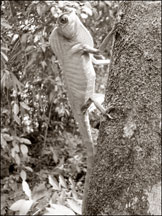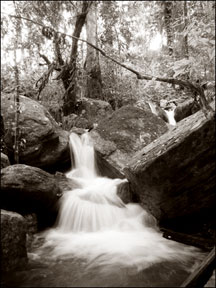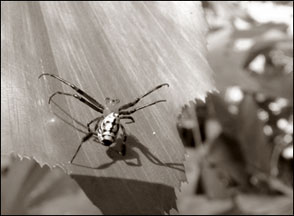Back to primeval splendour
by Sajitha Prematunge
 |
|
The Hump - nosed Lizard |

Pristine splendour |
An eerie cry like a woman in labour, is not uncommon in Mahausakanda
Kele. Some people believe it's the cry of Karamal bodilima (The
Hump-nosed Lizard) or the spirits it's possessed with. The Hump nosed
Lizard is one fascinating specimen out of the hundreds of thousands of
exquisite flora and fauna in the Mahausakanda regenerated rain forest.
Situated at the foothills of the Bambaragala Mookalana, Mahausakanda
protected area used to be a small patch of neglected rubber about 16
hectares in extent, located in Kiri-ealla, Ratnapura.
During a period of about 15 years when it was left alone to grow
wild, the seeds transferred from the adjacent forest has stimulated the
natural growth of many of the forest species. With nature trails across
different habitats a visit to the Mahausakanda regenerated rain forest
is educational, recreational as well as breath taking.
 We went through the winding road that was flooded on either side by
the torrential rains from the past two days; an ecologist and two
journalists cramped in the passenger seat of a Jeep, with blocked ears.
But no amount of discomfort was to take away our elation at seeing the
magnificent waterfall around the bend - the Bambarakanda falls. We went through the winding road that was flooded on either side by
the torrential rains from the past two days; an ecologist and two
journalists cramped in the passenger seat of a Jeep, with blocked ears.
But no amount of discomfort was to take away our elation at seeing the
magnificent waterfall around the bend - the Bambarakanda falls.
Implemented by the Ellawala Foundation, a charitable fund, the whole
concept is a long awaited wish come true for all concerned. Originally
an ingenious idea of late Mr. Lyn De Alwis, former director of wildlife
conservation and the Zoological Gardens Dehiwala, a group of
environmentalists and ecologists came together to regenerate a rain
forest at Mahausakanda in 2004 and was registered and legalized in 2005.
Nalini Ellawala, the coordinator, told the Sunday Observer "At one
time sustaining the estate was so expensive that we even considered
selling." She has spent over 10 million of her own money on this
project. "It costs almost Rs. 70,000 per month just to sustain the
project."
She explained that preserving this fragile ecosystem is of utmost
importance for the benefits it provides, such as conservation of
bio-diversity, services for human wellbeing, contribution to the
minimizing of global warming and educational and recreational purposes.
|

Wood spider |
Rain forests like the one in Mahausakanda can assist carbon
sequestration - the extraction of carbon dioxide by plants. Less than 5%
of total land surface remains as rain forests in Sri Lanka today. Trees
are the main source of air purification. Loss of more trees can mean
more pollution.
Nalini Ellawala says the response since its legalization in 2005 has
been extremely good. Six young men from the village were offered
employment as guides and trained on the principles of conservation and
re-generation. With a pen and pad still in hand the guides accompanied
us along the track.
With the passage of time they have turned in to a quite capable and
knowledgeable group much to the satisfaction of their trainers and
Nalini Ellawala herself. Apart from replantation efforts several other
activities have been implemented with and for the benefit of the locals
such as the manual removal of invasive species, development of research
facilities, awareness programmes and education programmes for students
of local schools.
A women's society and school level projects are now under way. The
project has direct contacts with 450 to 500 families of the area,
helping them improve their living conditions through cottage industries
such as production of Kithul treacle, bee's honey and handicrafts such
as the production of greeting cards, paper bags made of recycled paper
and used news papers.
Dr. Channa Bambaradeniya Coordinator, Asia Regional Species
Conservation Programme, IUCN told the Sunday Observer that exotic
species such as Pinus and Eucalyptus are not only harmful to native
species in forest regeneration, but also dries up the soil.
This type of project could be used as a modal by the private and
government sectors alike, for other similar reforestation projects. Dr.
Bambaradeniya explained the significance of Mahausakanda as a rain
forest "Imagine if there wasn't a rain forest here. The low laying lands
would be subjected to flash floods.
This regenerated rain forest acts like a sponge soaking up access
rain water." The main reason for this certain project to be a success is
because of its annual rain fall of over 3500mm, this helps quick growth,
but without the rain forest the low laying lands would have to face the
full fury of access rain water.
Dr. Manoj Fernando Executive Director, Melmadura, explained that most
people seek economical benefits even in conservation. He further
explained that this was a win-win situation where conservation can also
directly support human wellbeing. "Human scope of enjoyment is very
narrow; some think they can only enjoy life by getting drunk or earning
more money.
What's required is to develop a link between human wellbeing and
wildlife conservation, but some thing beyond simply enjoying wildlife -
we have to enjoy it while acquiring knowledge." Prohibition of alcohol
within the premises is to rehabilitate people who've become highly
dependant on alcohol.
At the end of 2006, more than 3000 plants have been introduced to an
already existing plant community and are doing exceedingly well having
grown to a height of over 2 meters within a period of two years.
Mahausakanda Kele is home to at least 200 species of flowering plants,
148 species of vertebrate animals - of which 20% is endemic - and 50
species of butterflies.
The birds observed included six species of winter migrants as well.
And a wealth of information on undiscovered species, wait unearthing. A
total of 06 species of freshwater fish, 11 amphibians, 33 inland
reptiles, 84 birds, 20 mammals, 148 vertebrates, 50 butterflies, 200
flowering plants has been found to date. Some of the woody plants found
in Mahausakanda Kele include Batu Na, Milla, Kitul, Waldel, Hora,
Rukkattana, Dawata, Gal veralu and Wal bombu.
Some of the fresh water fish found in the plentiful streams and ponds
of Mahausakanda are Striped Rasbora, Giant Danio and the endemic Banded
Mountain Loach. Calls of amphibians such as the endemic Wrinkled Frog
and several shrub frogs are quite common during dusk.
Commonly encountered reptiles include lizards and skinks. Sri Lanka
Lorikeet, Sri Lanka Layard's Parakeet, Pompadour Green Pigeon, Sri Lanka
Yellow-fronted Barbet and the Sri Lanka Grey Hornbill are some of the
birds that guests can encounter at the forest.
Mammals that have made their home here include the Wild boar, Black-naped
hare, Mongoose and Mouse deer. Other visitors to the area include the
rare and nationally threatened Otter and Fishing cat. Butterflies range
from large species such as the Blue Mormon to small species such as the
lycaenids and the Birdwing. Plus there are 125 species of bees in
Mahausakanda.
"The distribution of seeds through bats and birds are immensely
beneficial for the expansion of the forest." Explained Dilup
Chandranimal, the volunteer flora conservation advisor of the group.
These animals also assist the pollination process.
This is a photographers haven with different types of multi coloured
spiders. We encountered an Oriental white eyes, a male wood spider -
which was much smaller then its female counterpart, a Hump nosed Lizard
all in one short trek through one of the numerous nature trails
Mahausakanda rain forest offers.
The project has a cottage - with blissful terracotta clay on the
floor - which can accommodate ten to twelve people and a laboratory for
educational purposes, where wildlife enthusiasts, students and other
intellectuals are briefed on the importance of rain forests,
bio-diversity of the forest and to identify certain flora and fauna of
the Mahausakanda regenerated rain forest.
There are two days worth of observation for travellers who visit the
rain forest itself, apart from the Nadun Vihare and the adjoining
Kabaragala Reserve.
Something said by Dr. Manoj in his briefing upon our arrival was
echoed in Nalini Ellawala's words as we waited for the others to return
from a refreshing bath at the Tam Kepu Dola. "There are lots of means of
enjoyment even if you spend just one day in the forest.
Through all your senses from morning to dusk" "Did you hear that?
That's a migratory bird, it's been visiting the forest for some time
now" explained Nalini Ellawala obviously enjoying this pristine
splendour.
[email protected]
|
